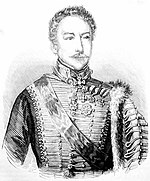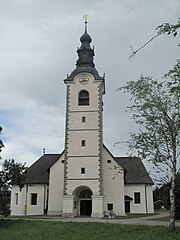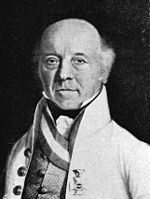Battle of Feistritz
The Battle of Feistritz (6 September 1813) saw an Imperial French corps led by Paul Grenier attack an Austrian brigade under August von Vécsey.
Feistritz im Rosental is located on the right bank of the Drava River near the southern border of Austria, about 16 kilometres (10 mi) southwest of Klagenfurt.
The Austrians made rapid gains in the south, but in Carinthia, Hiller's first bridgehead across the Drava River at Villach was eliminated by the Franco-Italian army of Eugène de Beauharnais, the viceroy of the Kingdom of Italy.
The minor victory only delayed the inevitable, and within a few weeks Eugène was compelled to abandon Illyria and fall back to the borders of the Kingdom of Italy.
[1] To rebuild his army in Germany for the 1813 campaign, Emperor Napoleon transferred four more divisions from the garrison of Italy to join the newly established IV and XII Corps.
The emperor then gave his stepson Eugène permission to organize a new army out of French and Italian draftees to defend the Kingdom of Italy.
Nevertheless, the army continued to expand and Eugène eventually renumbered his divisions 1 through 6, with the Italian Royal Guard kept as a discrete unit.
[5] In August 1813, Hiller's army consisted of an Advanced Guard under General-major Aron Stanisavlevics and divisions commanded by Feldmarschall-Leutnants Peter Marchal de Perclat, Johann Maria Philipp Frimont, Franz Marziani, Hannibal Sommariva, and Paul von Radivojevich.
Frimont's division had three brigades led by General-majors Franjo Vlašić, Ferdinand Daniel Pulszky, and August von Vécsey.
[6] Marziani's division was made up of a single brigade led by General-major Johann Mayer von Heldensfeld with seven line battalions.
[7] On 12 August 1813, the Austrian Empire declared war on Imperial France, putting the Illyrian Provinces and the Kingdom of Italy on the front lines.
Hiller sent Radivojevich and 10,000 troops of his left wing to capture first Karlovac (Karlstadt) and Novo Mesto (Rudolfswerth), and later Rijeka (Fiume) and Trieste.
[8] When the French first gained control of Illyria, many Croats hoped that the new masters would spur economic expansion and lighten their military obligations.
Over time, their hopes were not realized and when Radivojevich's columns crossed the frontier, the Croats rose in rebellion against the French occupation.
Though three Austrian divisions were in the area, Gratien managed to eject his foes from the town and drive them back to the east bank of the Drava.
He found a crossing point south of Klagenfurt and pushed troops across the river at Feistritz im Rosental around the end of August.
[12] Hiller was aware of recent French probes in the Feistritz area so he sent two battalions of grenadiers to nearby Schloss Hollenburg on the morning of 6 September 1813.
Vécsey entrenched his brigade along the Bärenthal ravine with his right flank on the Drava and his left on steep forested hills to the south.
As the center column crossed the Klein Dürrenbach ravine about 2.0 miles (3.2 km) west of Feistritz, it chased away some Austrian skirmishers and detached a battalion of the 84th Line to observe enemy movements on the north bank of the Drava.
From Jesenice in the upper Sava valley, Eugène directed two battalions of the Italian Guard to move north and clear away any Austrian outposts to the south of Feistritz.
The main assault began at 3:00 PM when Campi came down on the Austrian left flank while Quesnel and Schmitz attacked in front.
When units of the 9th Jägers saw the redoubt fall and French soldiers get into the ravine, they retreated from the Holy Cross Church and Cemetery into the Feistritz Castle.
After a voltigeur company of the 9th Line crossed the Bärenthal ravine, they were charged by a squadron of uhlans, but they managed to drive off the horsemen.
Momentarily stopped, the French units soon closed up and pushed their foes back to Sankt Johann im Rosental.
Though Hiller was aware of the significance of his bridgehead, he failed to properly support Vécsey's brigade by placing the nearest reinforcements a six-hour march distant.
[22] The Italian 3rd Line Infantry Regiment was routed, losing 60 killed, 200 wounded, 600 prisoners, two colors, two guns, and three caissons.
[23] On 11 September 1813, Austrians in Feldmarschall-Leutnant Franz Maria Philipp Fenner's command mounted a successful raid at Mühlbach in the South Tyrol, capturing 100 soldiers and provoking a deep withdrawal by General of Division Filippo Bonfanti who was then replaced.
On the 13th at Šmarje–Sap (St. Marein-Sap), Eugène personally led 3,300 men and six guns of the Italian Guard against Oberst Eugen Milutinovich's 1,000 Austrians and two artillery pieces.
The Austrians held on until dark before retreating and inflicted 420 casualties on their attackers while only losing 24 killed, 88 wounded, and three artillery pieces damaged.
This was followed by another minor disaster at Višnja Gora (Weichselburg) when General-major Matthias Rebrovich attacked General of Brigade Teodoro Lechi on 16 September.




